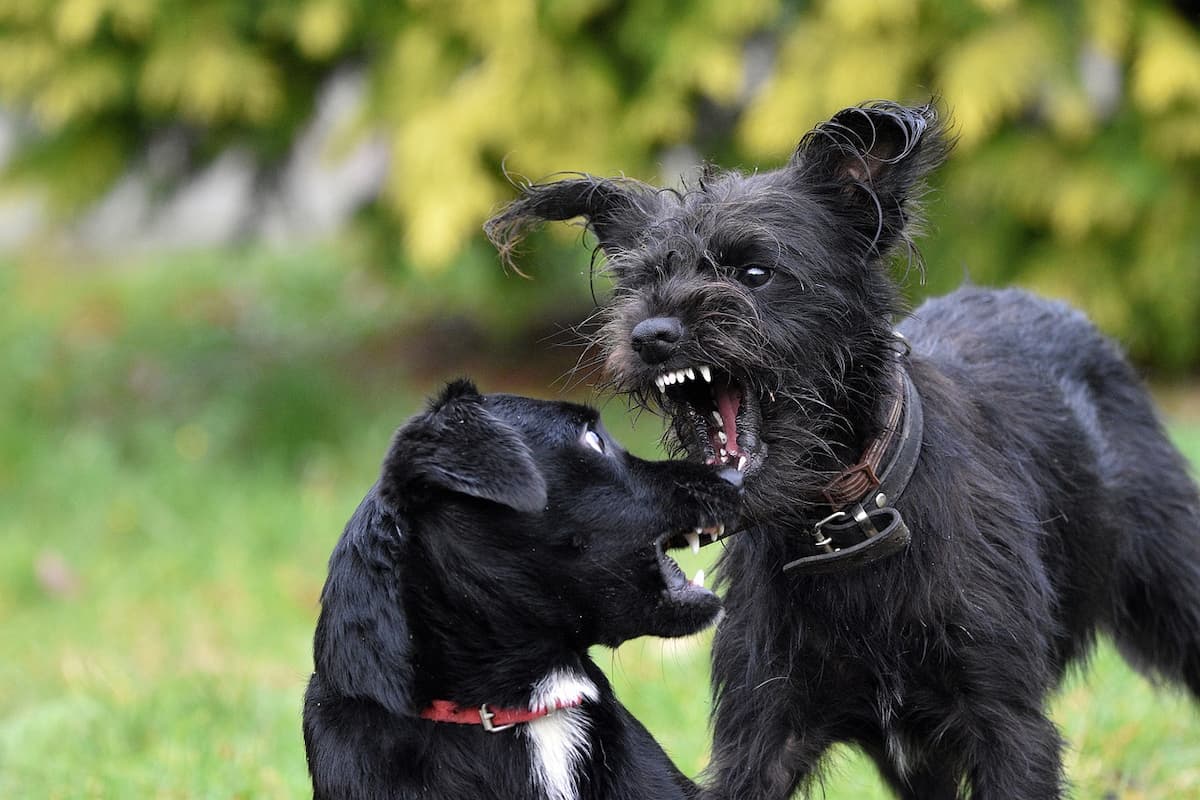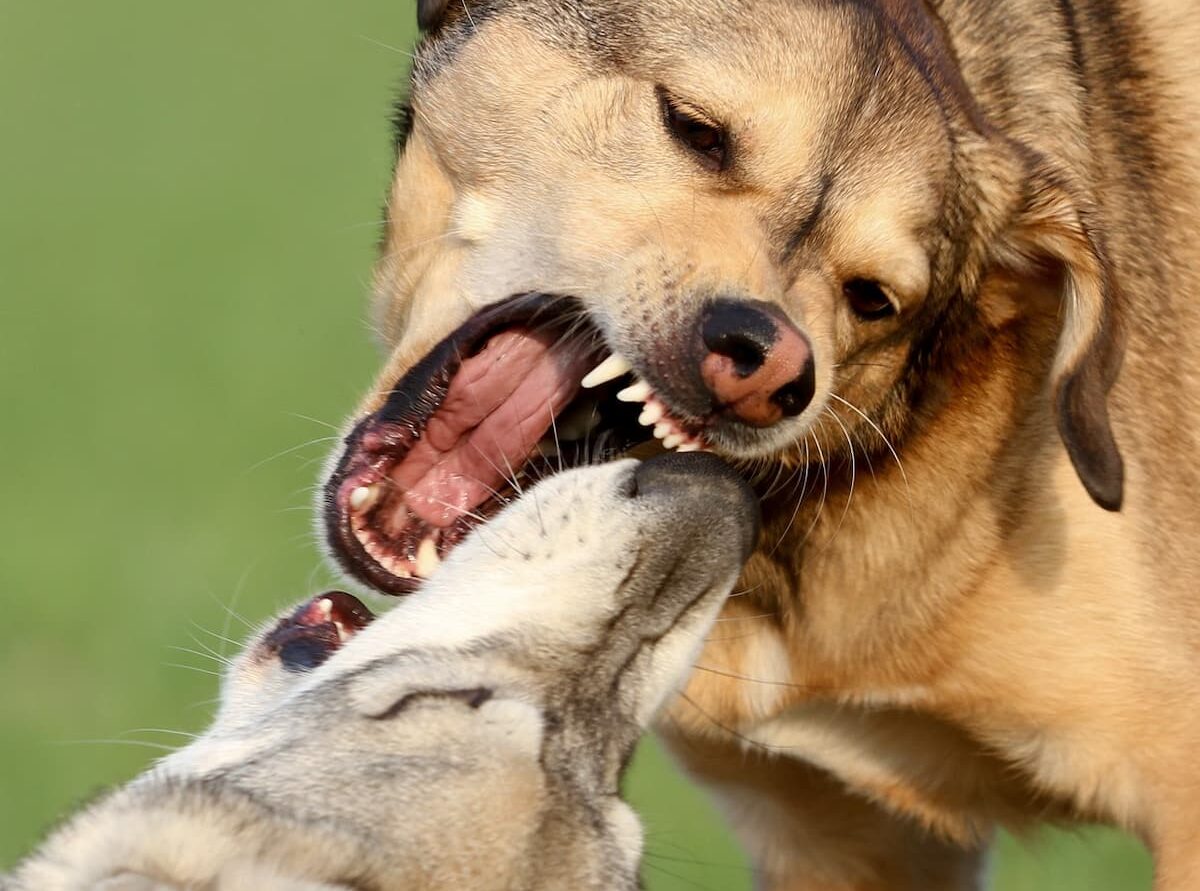Some dogs just can’t seem to get along no matter how long they’ve shared a roof.
Why exactly do dogs that live together fight?
Read on to find the answers.
Why Dogs Living Together Sometimes Have Fights
Living with dogs can be an incredibly rewarding experience, filled with love, companionship, and countless happy memories.
However, if you have multiple dogs living together under the same roof, you may have witnessed some squabbles between your furry friends.
It’s not uncommon for dogs that live together to occasionally have disagreements or even full-blown fights.
But have you ever wondered why this happens?
The truth is, dogs are complex creatures, just like humans.
They have their own personalities, preferences, and boundaries.
In a multi-dog household, conflicts can arise due to a variety of factors:
Territorial disputes: Dogs naturally have a territorial instinct, and living in close quarters can sometimes cause tensions to rise.
They might compete over resources such as food, toys, or even your attention.
Social hierarchy: Dogs are pack animals, and within a pack, there is usually a dominant leader and a social hierarchy.
When dogs live together, they may occasionally challenge one another to establish or maintain their positions within the pack.
Miscommunication: Dogs primarily communicate through body language, and sometimes misinterpretations can occur, leading to confrontations.
A well-meaning play gesture might be misread as aggression, or a dog may unintentionally invade another dog’s personal space, triggering a defensive response.
Possible Causes of Conflict Among Housemate Dogs
But what exactly causes dogs living in the same household to fight?
Here are several possible causes of conflict among housemate dogs:
1. Resource Guarding
Dogs are naturally territorial animals, and this can sometimes manifest in resource guarding behavior.
When dogs feel that their food, toys, or even sleeping areas are being threatened by another dog, it can lead to conflict.
This behavior often stems from a fear of scarcity or a desire to assert dominance.
To prevent resource guarding, ensure that each dog has their own designated space for eating and sleeping and that they have separate toys and feeding areas.
This will help minimize competition and reduce the likelihood of conflict.
2. Lack of Socialization
Dogs that haven’t been properly socialized with other dogs may struggle to understand and communicate with their housemates.
This can lead to misunderstandings, fear, and eventually conflict.
Socialization is crucial during a dog’s early developmental stages, but it’s never too late to work on improving social skills.
Make sure to expose your dogs to a variety of positive experiences with other dogs, such as playdates and obedience classes.
This will help them learn appropriate doggy etiquette and lessen the chances of conflicts arising.
3. Personality Clashes
Just like humans, dogs have different personalities and temperaments.
Sometimes, these personality clashes can lead to disagreements and conflicts.
For example, an assertive and dominant dog may clash with a more submissive and timid dog.
It’s important to understand and respect each dog’s individual needs and personality traits.
Creating an environment where each dog has space to be themselves and enforcing clear boundaries and rules can help prevent conflicts due to personality clashes.
While it can be disheartening to witness your furry friends engaging in skirmishes, it’s important not to panic.
Dogs, like humans, can have disagreements from time to time, and it doesn’t necessarily mean they no longer get along.
As responsible pet owners, being aware of these underlying causes and taking proactive measures can help promote harmony among your four-legged family members.
Practical Tips for Reducing Dog-on-Dog Tension
- Ensure Sufficient Resources: Provide multiple toys, food bowls, and separate spaces for each dog to reduce competition and resource guarding.
- Promote Positive Associations: Encourage bonding and positive experiences by engaging in group activities, such as walks or playtime.
- Establish Clear Hierarchy: Set and enforce consistent rules and boundaries to establish a peaceful pack dynamic.
- Gradual Introductions: When introducing a new dog to your household, take it slow and allow them to become familiar with each other’s scents and presence gradually.
- Consult a Professional: If tensions persist or escalate, seek guidance from a professional dog trainer or behaviorist who can provide personalized advice and support.
Remember, achieving harmony between dogs that live together requires patience, understanding, and consistent efforts.
With these practical tips, you’ll be well on your way to fostering a peaceful and loving environment for all your furry friends.
How to Manage and Prevent Sibling Rivalry in Dogs
Managing aggression
Now that you know why doggie squabbles occur, let’s explore some effective management techniques:
-
- Establish clear boundaries: Create separate feeding areas, designate specific zones for toys, and provide individual sleeping spaces to minimize the potential for resource guarding.
-
- Practice positive reinforcement: Reward good behavior and encourage positive interactions between your dogs with treats, praise, and playtime.
-
- Provide mental stimulation: Keep your dogs mentally engaged with puzzle toys, obedience training sessions, or interactive games to reduce boredom and prevent unwanted conflict.
Preventing aggression
Instead of waiting for aggression to occur, it’s always better to prevent it in the first place.
Here are some steps you can take:
-
- Early socialization: Expose your dogs to a variety of environments, people, and other dogs from a young age to help them develop good social skills.
-
- Supervise playtime: Keep a watchful eye during play sessions and intervene when necessary to redirect excessive roughness or tension.
-
- Consult a professional: If the aggression persists or escalates, consider seeking guidance from a professional dog trainer or behaviorist who can provide specialized advice tailored to your situation.
FAQ
Q: Okay, first things first.
Is it normal for dogs who live together to fight?
A: While it’s not exactly ideal, let’s just say it’s not completely unusual.
Dogs, just like us humans, have their own unique personalities, moods, and boundaries.
Sometimes, clashes can occur, leading to disagreements or even full-blown fights.
Q: What could be some reasons behind these fights?
A: Great question!
One common cause is resource guarding.
When dogs feel the need to protect their valued possessions like food, toys, or even their favorite sleeping spot, they may end up fighting over these coveted treasures.
It’s like two siblings arguing over the last slice of pizza!
Q: Ah, interesting analogy!
But are there any other factors that contribute to these conflicts?
A: Absolutely!
Another significant reason for fights among dogs who live together is a lack of proper socialization.
Just like us, dogs need to learn how to interact appropriately with others.
If they don’t receive enough socialization during their formative months, they might struggle with communicating their needs effectively, leading to misunderstandings and potential conflicts.
Q: That makes sense.
But what about hierarchy and dominance?
Can that play a role in fights too?
A: Yes, indeed!
Dogs are often known for their hierarchical behavior, and establishing dominance within a pack is ingrained in their nature.
If two dogs living together are constantly vying for the top spot, it can intensify tensions between them, potentially resulting in fights.
Just picture it as a power struggle for the “leader of the pack” title.
Q: Got it!
So, what can we do to prevent these fights between dogs living together?
A: The good news is, there are several steps you can take to minimize conflicts.
Firstly, it’s crucial to provide each dog with their own space and resources.
Making sure there are no reasons to compete for food, toys, or resting areas will decrease the likelihood of fights.
Additionally, providing proper socialization and training to your pups from a young age will help them develop better communication skills and reduce misunderstandings.
Q: And what if the fights continue to happen while dogs live together, despite our efforts?
A: If the situation persists or worsens, it’s highly advisable to seek professional help.
Certified dog trainers or animal behaviorists can provide specialized guidance to address the root causes of the conflicts and find suitable solutions.
Remember, ensuring the safety and well-being of both dogs involved should be the top priority.
A Summation of Key Takeaways
While it may be puzzling to witness our furry family members engaging in such heated disputes, it turns out there are a multitude of reasons behind their squabbles.
From resource guarding to lack of socialization, these conflicts can arise due to a variety of factors.
However, as responsible dog owners, it’s crucial for us to understand and address these issues to ensure a harmonious household for our four-legged companions.
Remember, seeking professional guidance, implementing proper training techniques, and providing ample love and attention are key ingredients in preventing and resolving these clashes.
With patience, understanding, and a bit of doggy psychology, we can maintain a peaceful environment that even our furry friends can wag their tails about.












